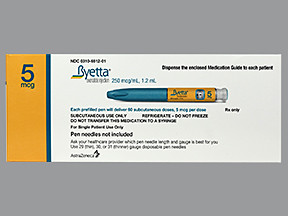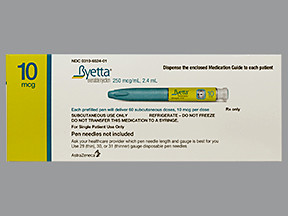EXENATIDE - INJECTION
PHONETIC PRONUNCIATION: (ex-EN-a-tide)
COMMON BRAND NAME(S): Byetta
GENERIC NAME(S): exenatide
Uses
USES: Exenatide is used with a proper diet and exercise program to control high blood sugar. It is used by people with type 2 diabetes. Controlling high blood sugar helps prevent kidney damage, blindness, nerve problems, loss of limbs, and sexual function problems. Proper control of diabetes may also lessen your risk of a heart attack or stroke. Exenatide is a diabetes drug that is similar to a natural hormone in your body (incretin). It works by increasing insulin release (especially after a meal) and decreasing the amount of sugar your liver makes. It also slows down food digestion in your stomach, decreases the amount of sugar absorbed from food, and may help decrease your appetite.
How to use EXENATIDE - INJECTION
HOW TO USE: Read the Medication Guide and the Pen User Manual provided by your pharmacist before you start using exenatide and each time you get a refill. Learn all preparation and usage instructions. If you have any questions, ask your doctor or pharmacist. Before using, check this product visually for particles or discoloration. If either is present, do not use the liquid. Before injecting each dose, clean the injection site with rubbing alcohol. Change the injection site each time to lessen injury under the skin. Inject this medication under the skin in the thigh, abdomen, or upper arm as directed by your doctor, usually twice a day. Injection should be done within 60 minutes before the morning and evening meals (or before the two main meals of the day, at least 6 hours apart). Exenatide should not be used after a meal since it will not work as well. If you are also using insulin, give exenatide and insulin as separate injections. Do not mix them. You may inject these medications in the same area of the body, but the injection sites should not be next to each other. Since exenatide slows down digestion of food/drugs in your stomach, certain medications (such as birth control pills, antibiotics taken by mouth) may not work as well if you take them at the same time. Take birth control pills or antibiotics at least 1 hour before using exenatide. If you must take these medications with food, take them with a meal or snack when you do not also take exenatide. Ask your doctor or pharmacist if you have any questions about when to take your medications. The dosage is based on your medical condition and response to treatment. Use this medication regularly to get the most benefit from it. To help you remember, use it at the same times each day. Carefully follow your diabetes management plan, including medications, diet, and exercise. Check your blood sugar regularly as directed by your doctor. Keep track of the results, and share them with your doctor. Tell your doctor if your blood sugar measurements are often too high or too low. Your doctor may need to adjust your diabetes medication, exercise program, or diet. Do not share your pen device with another person, even if the needle is changed. You may give other people a serious infection, or get a serious infection from them. Learn how to store and discard medical supplies safely.
Side Effects
Precautions
Interactions
Overdose
Images
Reviews
Faq for EXENATIDE - INJECTION
Exenatide injection is used to improve blood sugar control in adults with type 2 diabetes.
Exenatide injection works by increasing the release of insulin and decreasing the amount of glucose produced by the liver after meals. It also slows down the emptying of the stomach, which may help to control appetite and reduce food intake.
Exenatide injection is usually self-administered as a subcutaneous injection using a prefilled pen or syringe. It is typically injected into the thigh, abdomen, or upper arm.
Common side effects of exenatide injection include nausea, vomiting, diarrhea, headache, dizziness, and injection site reactions. These side effects are usually mild and go away on their own.
Exenatide injection can be used alone or in combination with other diabetes medications, such as metformin or insulin. However, it is important to consult with a healthcare professional before combining medications.
If a dose of exenatide injection is missed, it should be taken as soon as possible within the same day. If it is close to the time for the next scheduled dose, the missed dose should be skipped. Double doses should not be taken to make up for a missed dose.
Exenatide injection starts working within hours after the first dose, but it may take several weeks to see the full effect on blood sugar control.
Exenatide injection may cause hypoglycemia when used in combination with other diabetes medications that can lower blood sugar. It is important to monitor blood sugar levels and talk to a healthcare professional about the signs and symptoms of low blood sugar.
Exenatide injection is contraindicated in individuals with a personal or family history of medullary thyroid carcinoma, as well as in patients with a known allergy to exenatide. It should be used with caution in patients with kidney problems or a history of pancreatitis.
Warning
WARNING: This medication can cause a certain type of thyroid tumor (thyroid C-cell tumors) in rats. It is unknown if this medication can cause similar tumors in humans. Talk with your doctor about the benefits and risks of treatment with this medication. Do not use this medication if you have a personal/family history of a certain type of cancer (medullary thyroid carcinoma) or a certain inherited disease (multiple endocrine neoplasia syndrome type 2 or MEN 2). While using this medication, tell your doctor right away if you notice any signs of thyroid tumors, including an unusual growth or lump in the neck, difficulty swallowing, shortness of breath, unusual/lasting hoarseness.
Disclaimer
IMPORTANT: HOW TO USE THIS INFORMATION: This is a summary and does NOT have all possible information about this product. This information does not assure that this product is safe, effective, or appropriate for you. This information is not individual medical advice and does not substitute for the advice of your health care professional. Always ask your health care professional for complete information about this product and your specific health needs.


No Reviews Yet